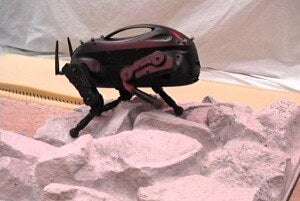
Sometimes robot videos just make me laugh. CSAIL at MIT has been working with Boston Dynamics’ robot Little Dog, helping it navigate rough terrain in novel ways. The scrappy quadruped can dynamically shifts its weight on two legs at a time, helping it climb slopes and stairs, and generally get around.And as soon as Little Dog gets where it’s going, it promptly flops down on its belly much like a real canine. The careful steps followed by exhausted collapse gets me every time. Check out the video from BotJunkie below, and look towards the end (1:44) to see for yourself.
Little Dog’s journey is part of Phase 2 of DARPA’s Learning Locomotion Program. As those who read our War 2.0 story know, a larger version of the robot, aptly named Big Dog, is being bred to work as a mule for soldiers in the field. That bot can haul loads and keep walking even after a hefty kick (see its video below). The navigating and stepping routines that CSAIL teaches Little Dog are going to be directly portable over to Big Dog.
Having a robot make its way on a rough path isn’t new. We’ve seen how Asimo navigated terrain using an overheard camera and symbolic shapes. CSAIL’s robotic gardeners also operated under self-guidance. Little Dog is doing much the same: an overhead camera helps the bot choose it’s next steps carefully while it makes decisions and maintains its balance dynamically.
The leaps and jumps it makes may not seem impressive, but there’s definitely potential there. Accurately moving in the air and planning where to land are some of the more difficult tasks walkers have to make on a routine basis. If you want to be furthered impressed by Little Dog’s stepping prowess, check out this video from last year. It looks like CSAIL decided to give the robots some Shaolin training. Very cool.
Pattern recognition, problem solving, and decision making are all necessary when walking, and they are all tasks humans excel at. In fact, these are perhaps the only skills where humans still defeat computers every time. The fact that CSAIL is helping Boston Dynamics and DARPA develop a robot that learns as it walks is important stuff. Robotic learning is still in its infancy, and as with human infants, walking is just the first of many goals. With a strong foundation in problem solving, all learning machines need to exceed human intelligence is time. That is if they don’t get tired and flop out first.


